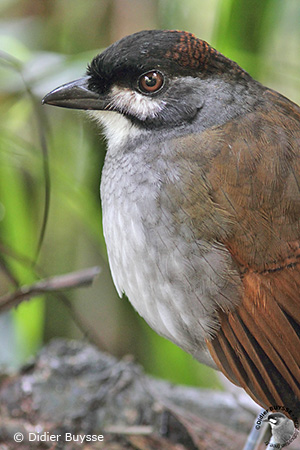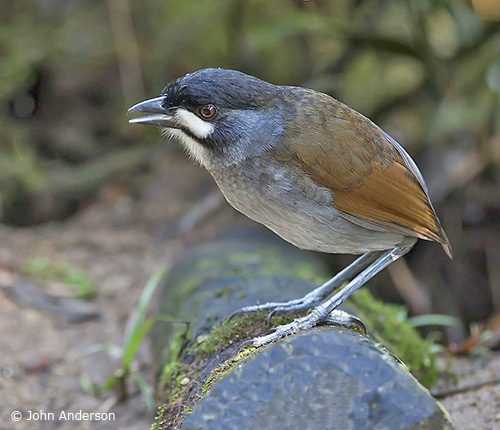
Fr: Grallaire jocotoco - Grallaire de Ridgely
Ang: Jocotoco Antpitta
All: Zügelfleck-Ameisenpitta
Esp: Tororoí Jocotoco
Ita: Pitta formichiera jocotoco
Nd: Jocotocomierpitta
Sd: jocotocomyrpitta
Photographers:
Roger Ahlman
Pbase Galleries Peru and Ecuador
John Anderson
John Anderson Photo Galleries
Didier Buysse
Vision d’Oiseaux
William Price
PBase-tereksandpiper & Flickr William Price
Dubi Shapiro
Dubi Shapiro Photo Galleries
Text by Nicole Bouglouan
Sources:
HANDBOOK OF THE BIRDS OF THE WORLD Vol 8 By Josep del Hoyo-Andrew Elliott-David Christie - Lynx Edicions - ISBN: 8487334504
BIRDS OF SOUTH AMERICA – Passerines - by Robert S. Ridgely and Guy Tudor – HELM Field Guides – ISBN: 9781408113424
First Description of the Nest of Jocotoco Antpitta (Grallaria ridgelyi)
New distributional record for the Jocotoco Antpitta Grallaria ridgelyi in south Ecuador
Fatbirder - Grallariidae – Antpittas
CREAGUS@Monterey Bay (Don Roberson)
Wikipedia, the free encyclopaedia
Jocotoco Antpitta
Grallaria ridgelyi
Passeriformes Order – Grallariidae Family
INTRODUCTION:
The Jocotoco Antpitta is confined to a small number of locations on the east slope of the Andes in SE Ecuador (Zamora-Chinchipe) and extreme NE Peru. It occurs at high elevations, between 2,300 and 2,650 metres.
It frequents the steep slopes in the wet, dense, mossy forests where the canopy is broken by patches of Chusquea bamboo.
It feeds on insects and spiders, but it takes primarily earth worms and other invertebrates.
The Jocotoco Antpitta is usually solitary. At the beginning of the breeding season, the male sings to establish the territory and attract a female. This species nests in an open, cup-shaped structure made of plant materials, built on tree trunk about 3-4 metres above the ground. Both parents share most of the nesting duties.
The name of the Jocotoco Antpitta pays tribute to the ornithologist Robert S. Ridgely. He took part in the initial discovering of the species in 1997, in the humid montane forest of southern Ecuador. The name “jocotoco” refers to the hooting calls of the male.
The scientific name ‘Grallaria” comes from the Latin “grallarius” meaning “one walking on stilts”.
The Jocotoco Antpitta has a restricted range where logging and gold mining are the main threats. The species is currently classified as Endangered.

DESCRIPTION OF THE BIRD:
Biometrics:
Length: 22-23 cm
Weight: 176 g
The Jocotoco Antpitta has medium-sized, rounded body with short wings, very short tail, and long legs.
The upperparts are rich olive-brown with a black wash becoming lighter from the mantle to the rump. On the upperwing, the flight-feathers have blackish inner webs and cinnamon outer webs. The upperwing-coverts are olive-brown with black band. Seen from the rear, grey rump, uppertail-coverts and very short tail are almost invisible, hidden under the wings.
On the underparts, chin and throat are white. Most of underparts are mainly pale grey, but darker on flanks with olive-brown wash. The undertail-coverts are olive-brown with narrow black bar.
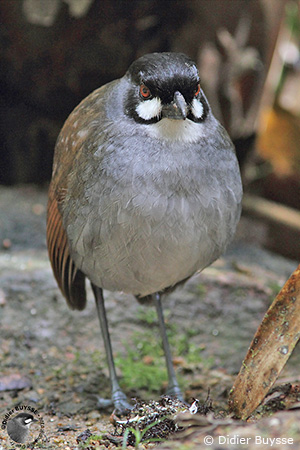
On the head, the crown is black whereas the head sides are grey. The nape is olive-brown. We can see a broad, white, somewhat shaggy white patch extending from the lores to below the eye. It is outlined below by narrow, black stripe. The ear-coverts are grey. Chin and throat are white.
The stout bill is black.
The eyes are dark red to crimson reddish-brown.
Long legs and feet are blue-grey.
Male and female are similar.
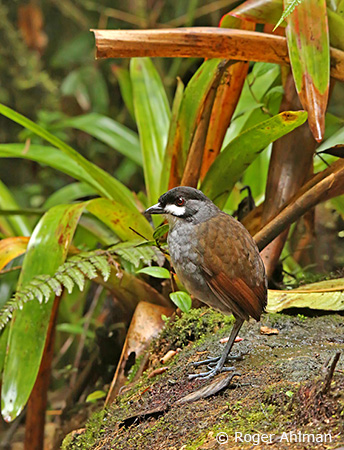
The juvenile resembles adult but it has chestnut crown with fine, black vermiculations extending onto the hindcrown and fading onto the nape until the upper back.
On the black bill, the lower mandible is paler, slightly tinged fleshy-orange. The eyes are duller than in adults, mostly dull red to red-brown.
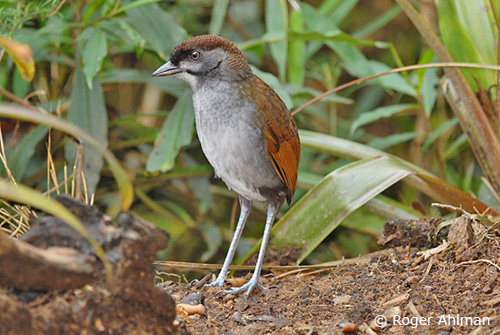
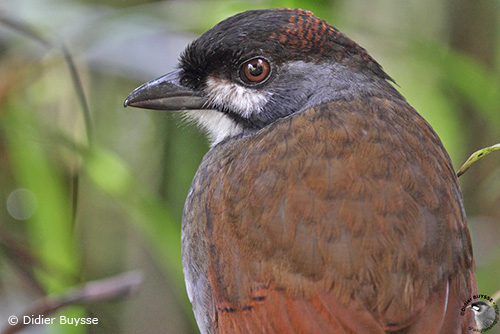
RANGE:
The Jocotoco Antpitta is resident within its restricted range in SE Ecuador and adjacent Peru where a population was discovered in 2006 in Cordillera del Cóndor in Cajamarca (Peru).
HABITAT:
The Jocotoco Antpitta frequents wet, mossy forests with large stands of Chusquea bamboo and Silvery-leaved “Cecropia” trees. It is often found on steep slopes covered with epiphyte-laden trees, usually near streams.
The species is visible between 2,250 and 2,700 metres of elevation.
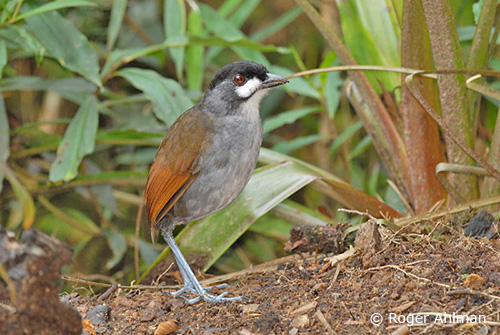
CALLS AND SONGS: SOUNDS BY XENO-CANTO
The call of the Jocotoco Antpitta is a mournful, low sound, a soft two-note “ho-co”. The alarm call given by both sexes is louder in volume and sometimes ends in a harsh churr. It is described as “hoo-krrr” or a staccato “hoo-co-kurr”.
The name of this species refers to these calls.
The melodious song is a drawn-out series of low-pitched, single hoots. It is used to establish the territory and attract a mate, and as contact with other individuals within the range. It can be heard through the cloud forest, adding a touch of enchantment to the habitat. Some duets between mates can be heard, with two different songs.
The Jocotoco Antpitta usually sings during the morning or at any time of the day. While singing, the bird throws the head back and fluffs the white feathers of the throat. It also pumps its short tail in synchrony with each hoot.
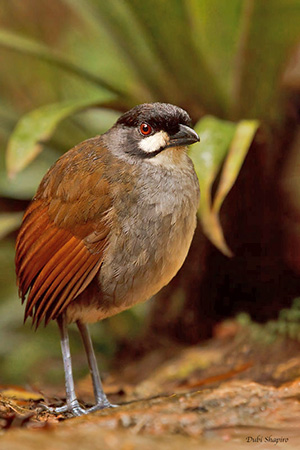
BEHAVIOUR IN THE WILD:
The Jocotoco Antpitta has long legs and large feet, well-adapted to the terrestrial habits. It usually feeds alone, but the members of a pair often forage together and fairly close to each other.
It feeds primarily on earthworms and other invertebrates such as beetles, ants, millipedes and larvae. It is a usual visitor to the worm-feeding stations.
While foraging, close (up to 4 metres) or on the ground of the wet forest, the bird probes the leaf-litter with its stout bill and overturns dead leaves and vegetation with both bill and feet. This species also follows swarms of montane Labidus species army ants to catch prey disturbed by the ants.
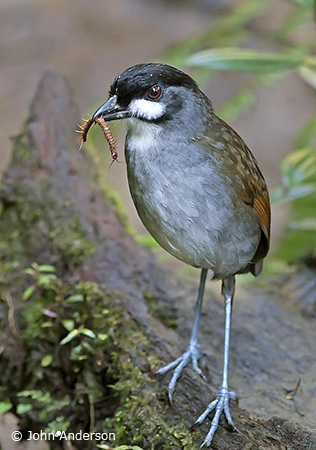
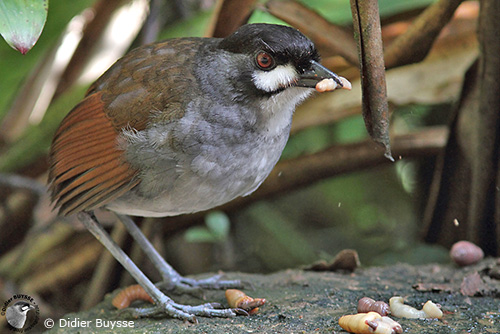
The breeding behaviour of the Jocotoco Antpitta is poorly known. The male sings to attract the female and to advertise the territory. It gives a series of repeated, low-pitched hooting “hoo” notes, sometimes during up to a minute or more. While singing, the white throat feathers are fluffed out and the male throws back its head.
This species builds a deep, open cup-shaped structure with plant materials in tree trunk, about 3-4 metres above the ground. The nest-site is often surrounded by understory of Chusquea bamboo. Both adults share most of the nesting duties.
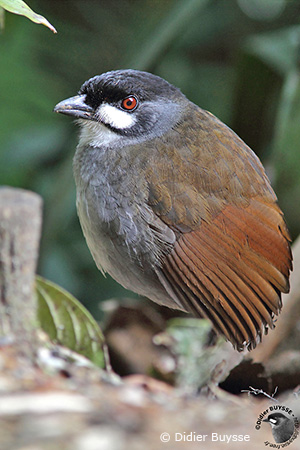
The Jocotoco Antpitta is resident within its restricted range.
It is a poor flier and does not perform long flights, as its small wings make it able to fly only over short distances. It is mainly a terrestrial bird, living and foraging mainly on the ground, thanks to the long legs very adapted to hop across the forest floor.
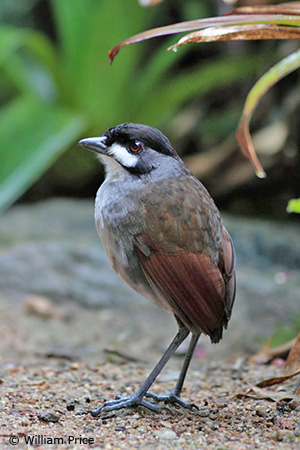
REPRODUCTION OF THIS SPECIES:
The breeding biology of the Jocotoco Antpitta is very poorly known. However, from an observation in November 2008 at the Tapichalaca Biological Reserve in extreme SE Ecuador, some information is now available.
The area is a steep terrain in the Andes at 2,500 metres of elevation, with high epiphyte density, a canopy height of 15-30 metres and a dense understory with Chusquea bamboo.
A nest was discovered thanks to adults carrying prey to the nest-site where a well feathered chick was waiting for food.
The nest was a large cup-shaped structure made of dead plant materials. It was lined inside with fine black rootlets and bare fern rachises. It was 18 cm tall, and 23,5 by 26 cm in diameter. The nest was supported by bromeliads, placed against the trunk and branch of a dead tree, about 3,6 metres above the ground. The vegetation including epiphytic ferns, orchids and Chusquea bamboo provided shade to the nest.
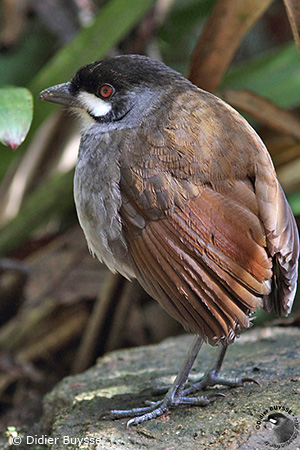
Inside the nest, the chick was well feathered with chestnut crown and upper breast, and cinnamon back with fine, black vermiculations. On the head, the white malar pattern was barely visible. The bill was dark on upper mandible with orange tip, and dull orange on lower mandible. The gape was bright orange.
Both parents were feeding the young, but nothing is known concerning the incubation. The clutch size is currently not documented, but 1 or 2 eggs are probably laid. The eggs are pale blue with scattered dark brown markings.
This species could reproduce twice a year, but more information is needed. Evidence suggests that it probably breeds between October and May.
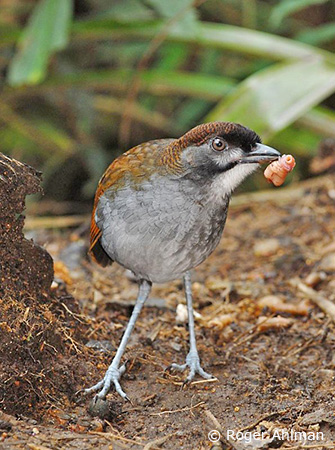
PROTECTION / THREATS / STATUS:
The Jocotoco Antpitta has restricted range where it occurs at low density.
It is threatened by degradation of its specific habitat by logging and gold mining. Forest degradation continues slowly throughout the range, including within Podocarpus National Park.
Fortunately, the private Tapichalaca Biological Reserve provides the species suitable habitat.
The number of mature individuals was estimated at 480-600 in 2020. This population is decreasing.
The Jocotoco Antpitta is currently classified as Endangered.
